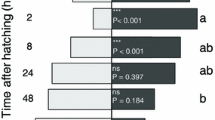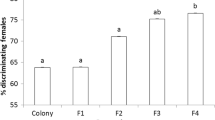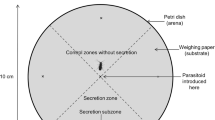Abstract
In solitary parasitoids, only one adult can emerge from a given host. In some of these species, when several eggs are laid on the same host, supernumerary individuals are eliminated by lethal larval fights. In the solitary parasitoid Anisopteromalus calandrae, the probability of a second larva winning the fight depends on the time elapsed since the first oviposition. The older the first egg is at the moment a second egg is laid, the less chance the second egg has of winning the competition. As a consequence, females of this species lay their eggs preferentially on recently parasitized hosts rather than on hosts parasitized by an egg about to hatch. Anisopteromalus calandrae females parasitize bruchid larvae located in cowpea seeds. In a series of choice test experiments using an artificial seed system, we demonstrated that the cue that allows parasitoid females to differentiate between hosts parasitized for different lengths of time comes from the host and not from the artificial seed or the previously laid egg. This cue is perceived at short range, indicating that the chemicals involved are probably partly volatile. Interestingly, although parasitism stops host development, cuticular profiles continue to evolve, but in a different way from those of unparasitized hosts. This difference in the host’s cuticular profile after parasitism, therefore, probably underlies the parasitoid female’s discrimination.



Similar content being viewed by others

References
Afsheen, S., Wang, X., Li, R., Zhu, C. S., and Lou, Y.-G. 2008. Differential attraction of parasitoids in relation to specificity of kairomones from herbivores and their by-products. Insect Sci. 15:381–397.
Bartlelt, R. J., Cossé, A. A., Petroski, R. J., and Weaver, D. K. 2002. Cuticular hydrocarbons and novel alkenediol diacetates from wheat stem sawfly (Cephus cinctus): natural oxidation to pheromone components. J. Chem. Ecol. 28:385–405.
Bartlelt, R. J. and Jones, R. L. 1983. (Z)-10-Nonadecenal: A pheromonally active air oxidation product of (Z,Z)-9,19 dienes in yellow-headed spruce sawfly. J. Chem. Ecol. 9:1333–1342.
Birkett, M. A., Campbell, C. A. M., Chamberlain, K., Guerrieri, E., Hick, A. J., Martin, J. L., Matthes, M., Napier, J. A., Pettersson, J., Pickett, J. A., Poppy, G. M., Pow, E. M., Pye, B. J., Smart, L. E., Wadhams, G. H., Wadhams, L. J., and Woodcock, C. M. 2000. New roles for cis-jasmone as an insect semiochemical and in plant defense. Proc. Natl. Acad. Sci. USA 97:9329–9334.
Blomquist, G. J. 2010. Structure and analysis of insect hydrocarbons, pp. 19–34. In Eds G. J. Blomquist and A.-G. Bagnères (ed.). Insect hydrocarbons. Cambridge Univ. Press.
Colazza, S., Aquila, G., De Pasquale, C., Peri, E., and Millar, J. 2007. The egg parasitoid Trissolcus basalis uses n -nonadecane, a cuticular hydrocarbon from its stink bug host Nezara viridula, to discriminate between female and male hosts. J. Chem. Ecol. 33:1405–1420.
Colazza, S., Salerno, G., and Wajnberg, E. 1999. Volatile and contact chemicals released by Nezara viridula (Heteroptera: Pentatomidae) have a kairomonal effect on the egg parasitoid Trissolcus basalis (Hymenoptera: Scelionidae). Biol. Control 16:310–317.
Darrouzet, E., Bignon, L., and Chevrier, C. 2007. Impact of mating status on egg-laying and superparasitism behaviour in a parasitoid wasp. Entomol. Exp. Appl. 123:279–285.
Darrouzet, E., Imbert, E., and Chevrier, C. 2003. Self-superparasitism consequences for offspring sex ratio in the solitary ectoparasitoid Eupelmus vuilleti. Entomol. Exp. Appl. 109:167–171.
Gauthier, N. and Monge, J. P. 1999. Could the egg itself be the source of the oviposition deterrent marker in the ectoparasitoid Dinarmus basalis? J. Insect Physiol. 45:393–400.
Gauthier, N., Monge, J. P., and Huignard, J. 1996. Superparasitism and host discrimination in the solitary ectoparasitoid Dinarmus basalis. Entomol. Exp. Appl. 79:91–99.
Godfray, H. C. J. 1994. Parasitoids, Beshavioral and Evolutionary Ecology. p. 473. Princeton University Press, New Jersey.
Goubault, M., Plantegenest, M., Poinsot, D., and Cortesero, A. M. 2003. Effect of expected offspring survival probability on host selection in a solitary parasitoid. Entomol. Exp. Appl. 109:123–131.
Hilker, M. and Mcneil, J. 2008. Chemical and behavioral ecology, pp. 92–112, in E. Wajnberg, C. Bernstein & J. J. M. van Alphen (eds.). Behavioral ecology of insect parasitoids: From theoretical approaches to field applications, Blackwell Publishing Ltd.
Hoffmeister, T. S. 2000. Marking decisions and host discrimination in a parasitoid attacking concealed hosts. Can. J. Zool. 78:1494–1499.
Howard, R. W. 2001. Cuticular hydrocarbons of adult Pteromalus cerealellae (Hymenoptera: Pteromalidae) and two larval hosts, angoumois grain moth (Lepidoptera: Gelechiidae) and cowpea weevil (Coleptera: Bruchidae). Ann. Emtomol. Soc. Am. 94:152–158.
Howard, R. W. and Baker, J. E. 2003. Morphology and chemistry of Dufour glands in four ectoparasitoids: Cephalonomia tarsalis, C. waterstoni (Hymenoptera: Bethylidae), Anisopteromalus calandrae, and Pteromalus cerealellae (Hymenoptera: Pteromalidae). Comp. Biochem. Physiol. B 135:153–167.
Hubbard, S. F., Marris, G., Reynolds, A., and Rowe, G. W. 1987. Adaptive patterns in the avoidance of superparasitism by solitary parasitic wasps. J. Anim. Ecol. 56:387–401.
Inoue, M. and Endo, T. 2008. Below-ground host location by Campsomeriella annulata (Hymenoptera: Scoliidae), a parasitoid of scarabaeid grubs. J. Ethol. 26:43–50.
Islam, K. S. and Copland, M. J. W. 2000. Influence of egg load and oviposition time interval on the host discrimination and offspring survival of Anagyrus pseudococci (Hymenoptera: Encyrtidae), a solitary endoparasitoid of citrus mealybug, Planococcus citri (Hemiptera: Pseudococcidae). Bull. Entomol. Res. 90:69–75.
Jaloux, B., Errard, C., Mondy, N., Vannier, F., and Monge, J. 2005. Sources of chemical signals which enhance multiparasitism preference by a cleptoparasitoid. J. Chem. Ecol. 31:1325–1337.
Kumazaki, M., Matsuyama, S., Suzuki, T., Kuwahara, Y., and Fijii, K. 2000. Parasitic wasp, Dinarmus basalis, utilizes oviposition-marking pheromone of host azuki bean weevils as host-recognizing kairomone. J. Chem. Ecol. 26:2677–2695.
Lebreton, S., Darrouzet, E., and Chevrier, C. 2009b. Could hosts considered as low quality for egg-laying be considered as high quality for host-feeding? J. Insect Physiol. 55:694–699.
Lebreton, S., Labarussia, M., Chevrier, C., and Darrouzet, E. 2009a. Discrimination of the age of conspecific eggs by an ovipositing ectoparasitic wasp. Entomol. Exp. Appl. 130:28–34.
Lizé, A., Carval, D., Cortesero, A.-M., Fournet, S., and Poinsot, D. 2006. Kin discrimination and altruism in the larvae of a solitary insect. Proc. R. Soc. B. 273:2381–2386.
Lockey, K. H. 1988. Lipids of the insect cuticle: origin, composition and function. Comp. Biochem. Physiol. 89B:595–645.
Meiners, T., Köpf, A., Stein, C., and Hilker, M. 1997. Chemical signals mediating interactions between Galeruca tanaceti L. (Coleoptera, Chrysomelidae) and its egg parasitoid Oomyzus galerucivorus (Hedqvits) (Hymenoptera, Eulophidae). J. Insect Behav. 10:523–539.
Nakamatsu, Y. and Tanaka, T. 2003. Venom of ectoparasitoid, Euplectrus sp. near plathypenae (Hymenoptera: Eulophidae) regulates the physiological state of Pseudaletia separata (Lepidoptera: Noctuidae) host as a food resource. J. Insect Physiol. 49:149–159.
Nakamatsu, Y. and Tanaka, T. 2004. Venom of Euplectrus separatae causes hyperlipidemia by lysis of host fat body cells. J. Insect Physiol. 50:267–275.
Onodera, J., Matsuyama, S., Suzuki, T., and Fujii, K. 2002. Host-recognizing kairomones for parasitic wasp, Anisopteromalus calandrae, from larvae of azuki dean weevil, Callosobruchus chinensis. J. Chem. Ecol. 28:1209–1220.
Outreman, Y., Le Ralec, A., Plantegenest, M., Chaubet, B., and Pierre, J. S. 2001. Superparasitism limitation in an aphid parasitoid: cornicle secretion avoidance and host discrimination ability. J. Insect Physiol. 47:339–348.
Peri, S., Sole, M. A., Wajnberg, E., and Colazza, S. 2006. Effect of host kairomones and oviposition experience on the arrestment behavior of an egg parasitoid. J. Exp. Biol. 209:3629–3635.
Rivers, D. B. and Denlinger, D. L. 1995. Venom-induced alterations in fly lipid metabolism and its impact on larval development of the ectoparasitoid Nasonia vitripennis (Walker) (Hymenoptera: Pteromalidae). J. Invertebr. Pathol. 66:104–110.
Rosi, M. C., Isidoro, N., Colazza, S., and Bin, F. 2001. Source of the host marking pheromone in the egg parasitoid Trissolcus basalis (Hymenoptera: Scelionidae). J. Insect Physiol. 47:989–995.
Saïd, I., Gaertner, C., Renou, M., and Rivault, C. 2005. Perception of cuticular hydrocarbons by the olfactory organs in Periplaneta americana (L.) (Insecta: Dictyoptera). J. Insect Physiol. 51:1384–1389.
Steidle, J. L. M., Steppuhn, A., and Ruther, J. 2003. Specific foraging kairomones used by a generalist parasitoid. J. Chem. Ecol. 29:131–143.
Steiner, S., Steidle, J. L. M., and Ruther, J. 2007. Host-associated kairomones used for habitat orientation in the parasitoid Lariophagus distinguendus (Hymenoptera: Pteromalidae). J. Stored Prod. Res. 43:587–593.
Stelinski, L. L., Oakleaf, R., and Rodriguez-Saona, C. 2007. Oviposition-deterring pheromone deposited on blueberry fruit by the parasitic wasp, Diachasma alloeum. Behaviour 144:429–445.
Stelinski, L. L., Rodrigez-Saona, C., and Meyer, W. L. 2009. Recognition of foreign oviposition-marking pheromone in a multi-trophic context. Naturwissenschaften 96:585–592.
Van Alphen, J. J. M. and Visser, M. E. 1990. Superparasitism as an adaptive strategy for insect parasitoids. Annu. Rev. Entomol. 35:59–79.
Van Baaren, J. and Nénon, J. P. 1996. Intraspecific larval competition in two solitary parasitoids, Apoanagyrus (Epidinocarsis) lopezi and Leptomastix dactylopii. Entomol. Exp. Appl. 81:325–333.
Van Dijken, M. J., Van Stratum, P., and Van Alphen, J. J. M. 1992. Recognition of individual-specific marked parasitized hosts by the solitary parasitoid Epidinocarsis lopezi. Behav. Ecol. Sociobiol. 30:77–82.
Visser, M. E., Luyckx, B., Nell, H. W., and Boskamp, G. J. F. 1992. Adaptive superparasitism in solitary parasitoids: marking of parasitized hosts in relation to the pay-off from superparasitism. Ecol. Entomol. 17:76–82.
Völkl, W. and Mackauer, M. 1990. Age-specific pattern of host discrimination by the aphid parasitoid Ephedrus californicus Baker (Hymenoptera: Aphidiidae). Can. Entomol. 122:349–361.
Weber, C. A., Smilanick, J. M., Ehler, L. E., and Zalom, F. G. 1996. Ovipositional behavior and host discrimination in three scelionid egg parasitoids of stink bugs. Biol. Control 6:245–252.
Acknowledgements
We thank E. Yates for correcting the English.
Author information
Authors and Affiliations
Corresponding author
Rights and permissions
About this article
Cite this article
Lebreton, S., Christidès, JP., Bagnères, AG. et al. Modifications of the Chemical Profile of Hosts after Parasitism Allow Parasitoid Females to Assess the Time Elapsed Since the First Attack. J Chem Ecol 36, 513–521 (2010). https://doi.org/10.1007/s10886-010-9781-7
Received:
Revised:
Accepted:
Published:
Issue Date:
DOI: https://doi.org/10.1007/s10886-010-9781-7



